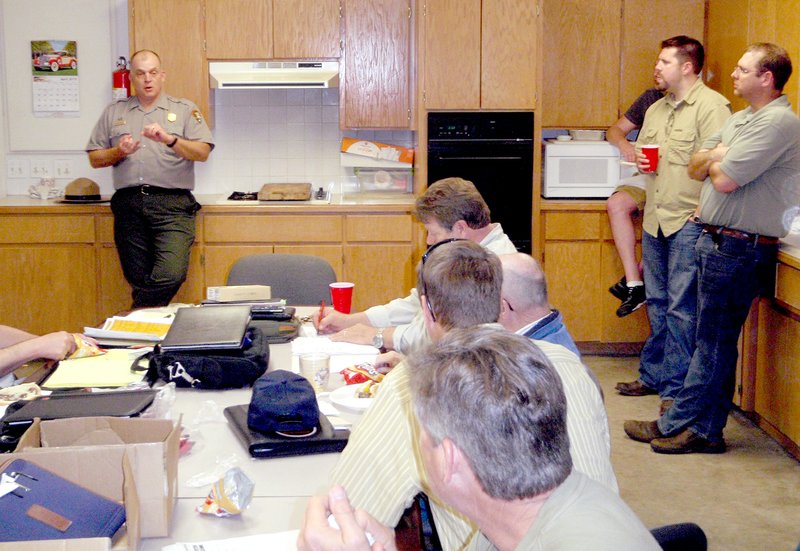When members of Benton County Quail heard about the vegetation management plan at Pea Ridge National Military Park, they quickly agreed to a $2,500 donation and volunteered time and machinery to the effort.
On Thursday, park superintendent Kevin Eads attended the group's monthly meeting at the Quail Barn west of Bentonville on Arkansas Highway 72.
"We're going to use that money for restoration of quail habitat -- specifically we'll treat 75 acres of Fescue grass to restore back native grasses," Eads said. Park employees will use herbicides to kill exotic vegetation. Fescue, while good for cattle, has no value for quail.
"Fescue doesn't provide the structure they need," Eads said. "Native grasses grown in clumps, have some bare soil, offer taller structure for protection and provide a good food source."
From previous restoration efforts, the staff knows that a native seed bank is hidden in the existing soil.
"It's pretty amazing: We kill the exotic plants and the native grasses do come back" without having to spread seed. He noted that some places in the 75 acres of targeted fields may require seeding, but that's not a problem.
For more than a decade, the park staff has been working to restore the battlefield to the way it looked in 1863 -- using what's called the cultural management plan. To do so has taken a vast amount of research. Starting with the historic map of the battle and on-site research, staff began placing 15 miles of fences where they were when the battle broke out. Orchards have been planted exactly where they were.
"But we didn't have much that talked about vegetation," Eads said. Working with University of Arkansas at Monticello professor Bob Weih, a base vegetation map was created using government land office notes made in 1836-37 (24 years prior to the battle), firsthand accounts from letters and diaries, aerial photographs taken in the 1940s and 1960s, quadrangle maps made in 1957 and 1988, the National Parks Service base map created to identify the land to be purchased to create the park in the 1950s, and various studies done over the years either specifically for the park, or covering the county and region.
All that created the vegetation management plan. Fire has been used as a tool to control species, and machinery is being used to remove invasive cedar trees.
"Everything interacts with the other -- it's all tied together," Eads said. "We remove cedar, native trees thrive; we get rid of Fescue and quail return."
The staff didn't necessarily set out to restore quail -- but that's been the result. For decades, because of changing land use, quail have been on a steep decline in northwest Arkansas.
A decade ago a quail was a rare sight, a covey was not seen.
"There were a few native birds that more than likely were struggling to hold on," Eads said. "Habit started improving and they are benefiting from that. Like I said, it's all tied together."
The vegetation management plan caught the attention of the Arkansas Game and Fish Commission, which brought in the National Bobwhite Conservation Initiative, a national group working to restore habitat for bobwhite quail.
"They've all got the same goal we have for habitat," Eads said. That's how the park staff found out that quail is an indicator species for quality of habitat. "If the habitat is good for quail, it's good for other birds and mammals large and small."
Today, while there's been exponential growth in the the quail population at the park, Eads said there's still not a lot of the birds. "We've gone from one or two pairs to multiple coveys."
That success caught the attention of the Benton County Quail members, who approached the park and began working with Parks Service biologist Nolan Moore to help implement the vegetation management plan.
After Eads explained what's going on to the BCQ members, a number volunteered even more help. One man asked if members could take their dogs, which are trained to find and point coveys, to the park to train the dogs as well as help survey the number of birds. The idea intrigued Eads because it would be an effective way to actually count the number of birds, rather than relying on listening for the bird's sounds. Of course they would not be shooting the birds, just flushing the coveys.
"I'm definitely interested to see if it can be done," Eads said. "It's an interesting way to involve partners and actually count the birds."
He noted that the Parks Service "is very thankful for their donation, and appreciate that they are willing to step forward and help. Our goals are aligned."
General News on 04/15/2015
